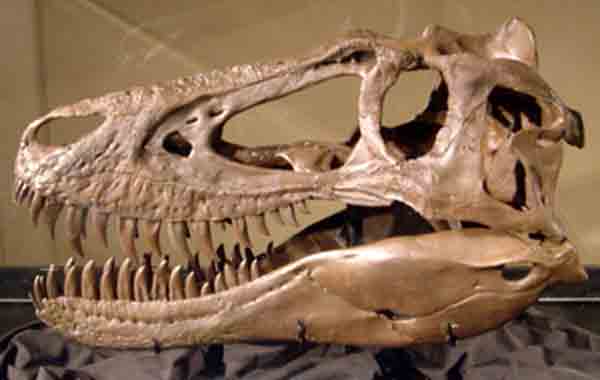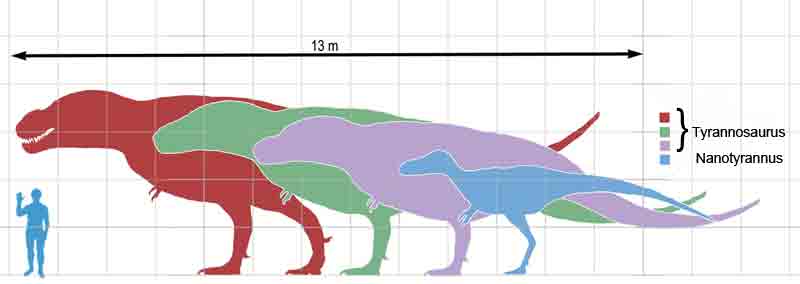Fossil Dinosaur Tooth mm 16 x 10 x 5 Tyrannosaurus T-rex Nanotyrannus lancensis Theropod Bipedal Carnivore Extinct Reptiles Mesozoic Cretaceous Collecting Paleontology Museum.
Very beautiful priceless high quality fossil specimen detailed, with great looking serration. Not restoration at all. Only a piece, as in photos.
Il Nanotyrannus (Saurischia, Theropoda, Carnosauria, Tyrannosauridae, Tyrannosaurinae), il cui nome significa "tiranno nano" o "piccolo tiranno", è un genere della famiglia dei tirannosauridi, vissuto nel Cretaceo superiore circa 70-65 milioni di anni fa in quello che oggi è il Nord America. E' conosciuto solo per due esemplari (forse tre), fra i quali un piccolo cranio lungo circa 1,2 m, dalla forma simile a quello del ben noto Tyrannosaurus, ma dalla forma più allungata e compressa verticalmente, dotato di un maggior numero di denti rispetto a a Tyrannosaurus, scoperto da Charles W. Gilmore nel 1942 e descritto nel 1946 come un modello di Gorgosaurus lancensis (ora noto come Albertosaurus). Nel 1988, il campione è stato nuovamente descritto da Robert T. Bakker e colleghi, sulla base delle ossa del cranio che, essendo fuse, appartenevano pertanto ad un esemplare adulto.

Alla luce di ciò, assegnarono il cranio ad un nuovo genere, chiamato Nanotyrannus per le sue apparenti piccole dimensioni. Tuttavia sorsero nuovi dubbi a riguardo, e alcuni paleontologi non lo ritengono un genere valido, dato che l'animale è stato contemporaneo di Tyrannosaurus rex, e pertanto lo ritengono un T. rex giovanile.
Dopo la scoperta nel 2001 di un nuovo esemplare di Nanotyrannus, soprannominato "Jane", sulla base dello scheletro dell'esemplare, si calcolò che l'animale doveva raggiungere una lunghezza di circa 6,50 metri, con un'altezza di 2 metri, per un peso che si aggirava tra i 600 kg e i 900 kg, di gran lunga inferiore al peso che ci si aspetterebbe da un giovane Tyrannosaurus. Le lunghe gambe e i grandi piedi dell'animale indicavano che l'animale era un grande velocista capace di raggiungere una velocità in corsa di 30-50 chilometri all'ora, facendone uno degli animali più veloci del suo ecosistema. Indipendentemente dal fatto che gli esemplari in questioni siano una nuova specie o esemplari giovanili di Tyrannosaurus, i paleontologi pensano che gli animali in vita fossero coperti da uno strato più o meno esteso di piume o protopiume.
Tra le principali differenze che i paleontologi a favore della teoria di Bakker sulla quale il Nanotyrannus rappresenterebbe una specie a parte da Tyrannosaurus, vi sono il numero dei denti. Il Nanotyrannus possedeva molti più denti nelle sue fauci, contando ben 14-15 denti per ciascun lato della mascella superiore e 16 denti in ciascun lato della mascella inferiore. Dal canto suo il Tyrannosaurus disponeva di ben 11-12 su ogni lato della mascella superiore e 11-14 in quella inferiore. Le implicazioni esatte di questa differenza nel numero di denti è molto controverso. In uno studio del 1999 sui modelli di crescita dei tirannosauridi, il paleontologo Carr ha dimostrato che, in Gorgosaurus libratus, il numero di denti diminuiva con la crescita dell'animale e ha usato tali dati per sostenere l'ipotesi che il Nanotyrannus fosse solo un esemplare giovane di T. rex. Tuttavia tale ipotesi fu smentita e screditata da un'accurata ricerca sui modelli di crescita di Tarbosaurus bataar (animale maggiormente imparentato con Tyrannosaurus), esponendo che durante la crescita questi animali non perdevano i denti, affermando anche i livelli e i modelli di crescita di Tyrannosaurus e Gorgosaurus sono molto diversi in quanto fanno parte di due diverse sottofamiglie. La prova di tale teoria arrivò nel 2006 con il ritrovamento del cranio di un giovane Tarbosaurus che contava lo stesso numero di denti di un adulto, dando un'ulteriore prova che il Nanotyrannus fosse un genere a se stante. Ulteriore prova della distinzione di Nanotyrannus da Tyrannosaurus, suggerita da Larson oltre che alla diversa costituzione del cranio, sono le zampe anteriori che in Nanotyrannus sono ben più lunghe (in relazioni al corpo), presentando anche falangi più grandi e una forcula più estesa.
Un'ulteriore prova, scoperta più di recente, arriva dai modelli 3D delle cavità del cervello del cranio olotipo di Nanotyrannus e quello di Tyrannosaurus, che mostrano che la posizione dei vasi sanguigni e i nervi ottici sono posti in una differente posizione, ad ulteriore prova che i due animali siano dei generi separati.
L'attuale studio scientifico su Jane, portato avanti da Bakker, Larson, e Currie, potrà aiutare a determinare se Nanotyrannus è una specie a sé, se rappresenta una forma giovanile di T. rex, o se è una nuova specie identificata precedentemente come Tirannosauro.

Nel 2005, una conferenza sul Tyrannosaurus e il Nanotyrannus ha interpretato la scoperta di Jane come una conferma che il Nanotyrannus fosse un giovane T. Rex o una specie strettamente collegata, mentre altri paleontologi continuano a sostenere l'ipotesi che il Nanotyrannus sia un genere distinto.
Alla fine del 2011, venne pubblicata la notizia di una favolosa scoperta avvenuta nel 2006: il ritrovamento di uno scheletro quasi completo di Nanotyrannus insieme ad un ceratopside. Il campione è stato studiato da Robert Bakker e Pete Larson, che hanno subito identificato il ceratopside come un Triceratops. L'esemplare di Nanotyrannus, soprannominato "Bloody Mary", presentava delle braccia molto lunghe di quasi 3 piedi di lunghezza, in contrasto con le braccia corte del Tyrannosaurus, anche se tale affermazione è ancora da verificare in quanto il campione "Bloody Mary" è sprovvisto di mani.
Il fatto che l'esemplare "Bloody Mary", fisicamente più piccola, sia stato ritrovato accanto a un Triceratops notevolmente più grande, fa supporre che il Nanotyrannus cacciasse in branco. L'ipotesi di Robert Bakker sulle abitudini gregarie dei Nanotyrannus sarebbe provata dal ritrovamento di ben 30 denti da diversi Nanotyrannus all'interno della carcassa del Triceratops, suggerendo che l'erbivoro sia riuscito a ucciderne uno, per poi essere sopraffatto dal resto del branco.
Attualmente, poiché i due generi mostrano piccole differenze, come il numero di denti più elevati in Nanotyrannus, si tende a raccomandare la continuata separazione dei due fino a che ulteriori scoperte non chiariscano definitivamente la situazione.
real fossil young T-rex tooth tip, mm 8 x 6 x 3, only a piece, as in pictures.
A very beautiful piece, higth quality specimen detailed with good looking serrations, no restoration at all.
The Nanotyrannus (Saurischia, Theropoda, Carnosauria, Tyrannosauridae, Tyrannosaurinae), whose name means "tyrant dwarf" or "little tyrant", is a genus of the family of tyrannosaurids, lived in the Upper Cretaceous about 70-65 million years ago in that that today is North America. It is known only for two specimens (maybe three), including a small skull about 1.2 m long, similar in shape to the well-known Tyrannosaurus, but with a more elongated and vertically compressed shape, with a greater number of teeth compared to aa Tyrannosaurus, discovered by Charles W. Gilmore in 1942 and described in 1946 as a model of Gorgosaurus lancensis (now known as Albertosaurus). In 1988, the sample was again described by Robert T. Bakker and colleagues, based on the skull bones which, being fused, therefore belonged to an adult specimen.

In light of this, they assigned the skull to a new genus, called Nanotyrannus for its apparent small dimensions. However new doubts arose about it, and some paleontologists do not consider it a valid genre, since the animal was a contemporary of Tyrannosaurus rex, and therefore they consider it a juvenile T. rex.
After the discovery in 2001 of a new specimen of Nanotyrannus, nicknamed "Jane", based on the skeleton of the specimen, it was calculated that the animal had to reach a length of about 6.50 meters, with a height of 2 meters, for a weight ranging between 600 kg and 900 kg, far less than the weight one would expect from a young Tyrannosaurus. The long legs and big feet of the animal indicated that the animal was a great sprinter capable of reaching a speed of 30-50 kilometers per hour, making it one of the fastest animals in its ecosystem. Regardless of whether the specimens on issues are a new species or juvenile Tyrannosaurus specimens, paleontologists think that the animals in life were covered by a more or less extensive layer of feathers or protophane.
Among the main differences that paleontologists in favor of Bakker's theory on which the Nanotyrannus would represent a separate species from Tyrannosaurus, are the number of teeth. The Nanotyrannus possessed many more teeth in its jaws, counting as many as 14-15 teeth on each side of the upper jaw and 16 teeth on each side of the lower jaw. On the other hand, the Tyrannosaurus had 11-12 on each side of the upper jaw and 11-14 on the lower side. The exact implications of this difference in the number of teeth is very controversial. In a 1999 study on tyrannosauride growth patterns, paleontologist Carr showed that, in Gorgosaurus libratus, the number of teeth decreased with the growth of the animal and used this data to support the hypothesis that the Nanotyrannus was only a young specimen of T. rex. However, this hypothesis was denied and discredited by careful research on the growth patterns of Tarbosaurus bataar (animal most related to Tyrannosaurus), exposing that during growth these animals did not lose their teeth, also affirming the levels and patterns of growth of Tyrannosaurus and Gorgosaurus are very different as they are part of two different subfamilies. The proof of this theory came in 2006 with the discovery of the skull of a young Tarbosaurus that counted the same number of teeth as an adult, giving further proof that the Nanotyrannus was a genus in its own right. Further proof of the distinction of Nanotyrannus from Tyrannosaurus, suggested by Larson as well as to the different constitution of the skull, are the front legs which in Nanotyrannus are much longer (in relation to the body), also presenting larger phalanges and a more extended forceps.
A further test, more recently discovered, comes from the 3D models of the cranial cavities of the skull olotype of Nanotyrannus and that of Tyrannosaurus, which show that the position of the blood vessels and the optic nerves are placed in a different position, further proof that the two animals are of separate genera.
The current scientific study on Jane, carried out by Bakker, Larson, and Currie, will help determine if Nanotyrannus is a species in itself, if it represents a juvenile form of T. rex, or if it is a new species previously identified as Tyrannosaurus.

In 2005, a conference on Tyrannosaurus and Nanotyrannus interpreted Jane's discovery as a confirmation that the Nanotyrannus was a young T. Rex or a closely related species, while other paleontologists continue to support the hypothesis that Nanotyrannus is a distinct genus .
At the end of 2011, the news was published of a fabulous discovery in 2006: the discovery of an almost complete skeleton of Nanotyrannus together with a ceratopside. The sample was studied by Robert Bakker and Pete Larson, who immediately identified ceratopside as a Triceratops. The specimen of Nanotyrannus, nicknamed "Bloody Mary", had very long arms of almost 3 feet in length, in contrast to the short arms of the Tyrannosaurus, although this statement is yet to be verified as the champion "Bloody Mary" is without hands.
The fact that the physically smaller "Bloody Mary" was found next to a considerably larger Triceratops suggests that the Nanotyrannus was hunting in a pack. Robert Bakker's hypothesis on the gregarious habits of the Nanotyrannus would be proven by the discovery of 30 teeth from different Nanotyrannus inside the carcass of Triceratops, suggesting that the herbivore managed to kill one, and then be overwhelmed by the rest of the herd.
Currently, since the two genera show small differences, such as the highest number of teeth in Nanotyrannus, we tend to recommend the continued separation of the two until further discoveries definitively clarify the situation.



